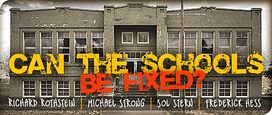Lead Essay
Twenty-five years ago this month, a Reagan-appointed blue-ribbon committee published a blockbuster study, A Nation at Risk, about the sorry state of American education. In this month’s lead essay, the Economic Policy Institute’s Richard Rothstein gives his critical assessment. “In 1983, A Nation at Risk misidentified what is wrong with our public schools and, consequently, set the nation on a school reform crusade that has done more harm than good,” Rothstein writes. “The diagnosis … was flawed in three respects: First, it wrongly concluded that student achievement was declining. Second, it placed the blame on schools for national economic problems over which schools have relatively little influence. Third, it ignored the responsibility of the nation’s other social and economic institutions for learning.”
Response Essays
In his reply, education entrepreneur Michael Strong challenges Rothstein’s key claims about the success of public schools and their relative unimportance for the further economic advance of the poor. He argues that the attachment to the status quo system of public education is “irrational.” Drawing on his experience as the principal of a successful charter school, Strong emphasizes the importance of the freedom to innovate. “The first nation that creates an educational system that allows educational entrepreneurs significant freedom to innovate will, over time, develop a significant advantage in the global marketplace. I’d prefer that the United States lead this movement rather than follow it.”
The Manhattan Institute’s Sol Stern detects “two Richard Rothsteins.” The first praises the public schools for improving student performance and for narrowing inequalities in student achievement. The second argues that nothing further can be done by the schools; for added progress we need other forms of social and political reform. “Either schools are able to significantly overcome family and neighborhood deficits that children bring to the classroom (and therefore ought to be judged by that standard) or they cannot be expected to overcome the social and economic deficits,” Stern writes. “But [Rothstein] perversely insists on having it both ways.” In stark contrast, Stern argues that test scores have become worse, that schools bear the responsibility, but that they can improve through a regime of standards.
Frederick Hess, the Director of Education Policy Studies at the American Enterprise Institute, concedes the premises of Richard Rothstein’s argument but contests their implications for the future of education. According to Hess, the key failing of A Nation at Risk was its too-easy acceptance of “the familiar institutions and practices of K-12 schooling.” As a consequence, the nature of teaching and teacher education has barely changed, despite deep changes in the broader labor market. And even the school choice movement has fallen victim to “the dangers of trying to paste preferred policies atop existing arrangements.” Hess concludes that “we must reject both excuse-mongering and overwrought hyperbole in favor of a steely willingness to revisit the shopworn assumptions and tired verities that have so long characterized school reform on the left and the right.”

